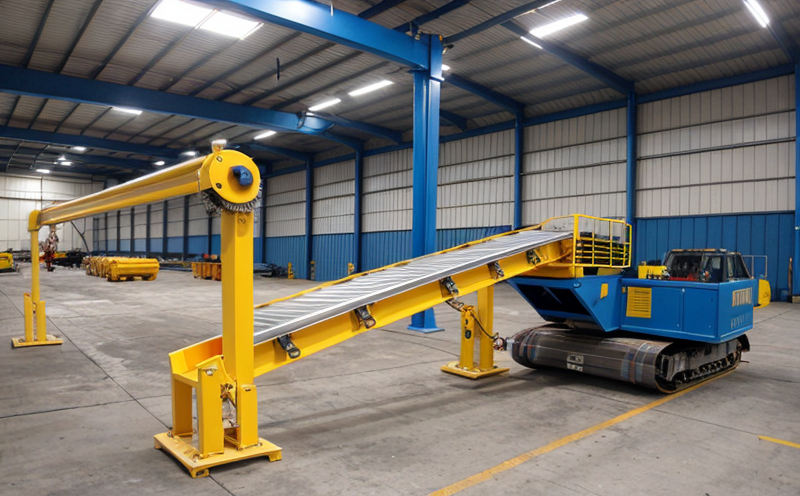DIN 22258 Belt Splice Fatigue Testing
The DIN 22258 standard is a crucial document within the realm of conveyor belt testing. This norm specifies procedures for fatigue testing of spliced conveyor belts, which are used in mining and other industrial applications where continuous operation is essential.
The primary purpose of this test is to ensure that the splice joint of conveyor belts can withstand repeated loading over extended periods without failure. The standard aims to provide a consistent method for evaluating the durability and reliability of these joints under conditions similar to those encountered during actual use.
To perform DIN 22258 testing, several key parameters must be considered:
- Splice length
- Loading rate
- Testing duration
The test setup involves subjecting the splice to cyclic loading until failure or a predetermined number of cycles. This ensures that any potential weaknesses in the joint are identified before they lead to operational issues.
Before starting the test, it's important to prepare the specimen according to specified guidelines. Typically, this includes cleaning and inspecting the belt segment to ensure there are no pre-existing defects or damages that could affect the outcome of the test.
The testing apparatus used for DIN 22258 is designed specifically for fatigue testing of conveyor belts. It consists of a loading frame capable of applying controlled cyclic loads, along with monitoring equipment to record stress-strain behavior and other critical data points throughout the test cycle.
Upon completion of the test, detailed reports are generated based on the collected data. These reports typically include information about the number of cycles before failure, any observed deformation patterns, and recommendations for improving splice design if necessary.
DIN 22258 testing plays a vital role in maintaining high standards within the mining industry by ensuring that conveyor belts used in critical operations are robust enough to handle heavy loads consistently. By adhering to this standard during production and maintenance phases, companies can significantly reduce downtime due to belt failures and improve overall efficiency.
Understanding the importance of proper splice design and implementation is crucial for achieving long-term reliability from conveyor systems. Regular testing according to DIN 22258 helps maintain these standards across all relevant sectors where robust conveying solutions are required.
Eurolab Advantages
At Eurolab, we pride ourselves on delivering comprehensive and reliable services tailored specifically for the mining industry. With our state-of-the-art facilities and experienced team of professionals, you can trust us to provide accurate results every time.
We offer several advantages when it comes to DIN 22258 testing:
- Accurate and consistent test results
- Compliance with international standards
- Expertise in various sectors including mining
Our dedicated team works closely with clients to understand their unique needs and requirements, ensuring that each project receives the attention it deserves. Whether you need routine testing or one-off assessments, we have the resources and expertise to meet your expectations.
We also stay up-to-date with industry trends and technological advancements, allowing us to offer innovative solutions that enhance performance while minimizing costs. Our commitment to quality ensures that our clients receive nothing less than top-notch service at all times.
Quality and Reliability Assurance
The importance of quality assurance cannot be overstated in industries like mining, where safety and efficiency are paramount. By incorporating DIN 22258 belt splice fatigue testing into your regular maintenance schedule or as part of new equipment procurement processes, you can significantly enhance the reliability of conveyor systems.
Quality assurance measures help identify potential problems early on, preventing costly repairs down the line and ensuring continuous operation without interruptions. When performed by certified laboratories such as Eurolab, these tests provide peace of mind knowing that every aspect has been thoroughly evaluated according to recognized standards.
In addition to testing splices for durability, it's also advisable to inspect other components such as pulleys, idlers, and frames regularly. This holistic approach ensures a well-maintained system capable of handling the demands placed upon it day after day.
By prioritizing quality assurance practices, companies in the mining sector can expect improved productivity levels along with reduced maintenance costs over time. Investing in robust infrastructure not only benefits current operations but also sets a foundation for future growth and success within competitive markets.
International Acceptance and Recognition
The DIN 22258 standard is widely recognized across various industries, including mining, due to its stringent requirements and proven effectiveness in evaluating splice fatigue. Its international acceptance underscores the importance placed on maintaining high-quality standards for conveyor belt systems.
Countries around the world have adopted this norm as part of their quality control protocols because it provides a uniform methodology that can be consistently applied regardless of location or manufacturer. This consistency contributes significantly to global harmonization efforts aimed at reducing discrepancies between different testing methods used locally.
Many large corporations involved in mining operations across continents rely on DIN 22258 as one of their primary criteria when selecting suppliers and evaluating performance. By ensuring compliance with this standard, companies can demonstrate their commitment to excellence while also gaining a competitive edge through superior product offerings.
The widespread adoption of DIN 22258 reflects the growing recognition among stakeholders that rigorous testing is essential for achieving reliable results. As more organizations embrace these practices, we anticipate further expansion into new territories where similar levels of scrutiny are needed.





